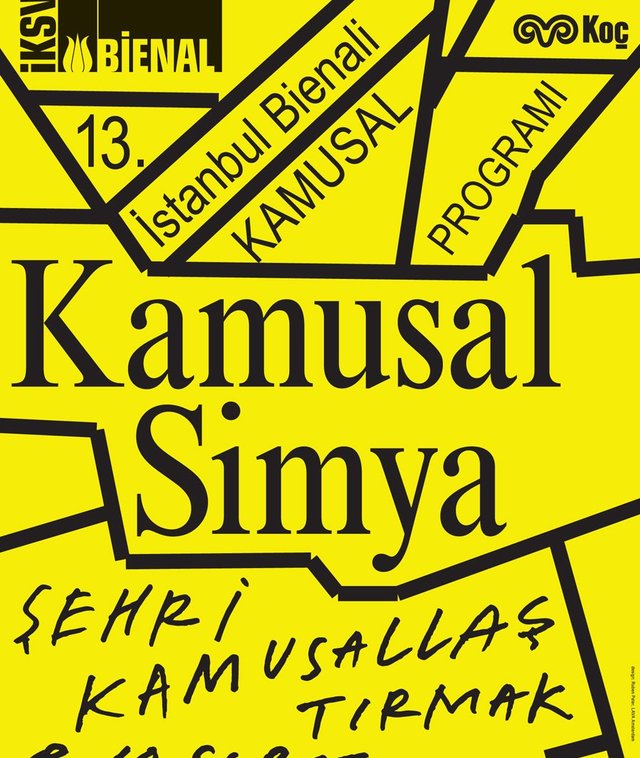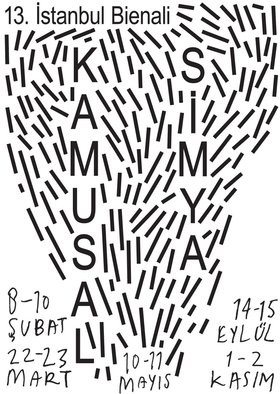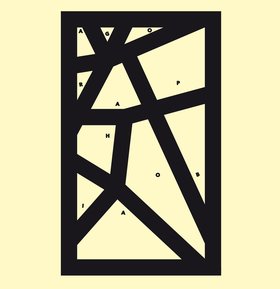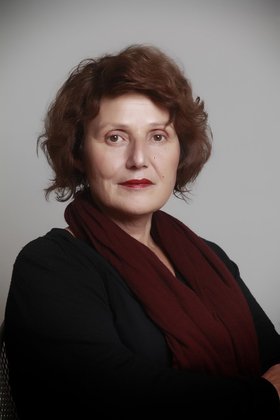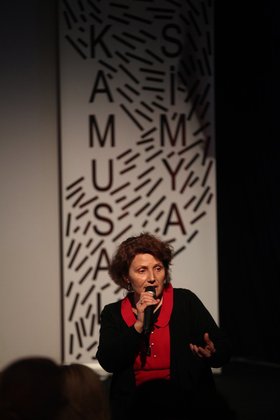Interviews
The public domain has opened up!
Fulya Erdemci in conversation with Basak Senova
Fulya Erdemci is the curator of the 13th Istanbul Biennial, Anne Ben Barbar Mıyım? or Mom, Am I Barbarian? (14th September – 20th October 2013). The theme for the biennial was decided well before the eruption of protests in Turkey, ignited by the planned demolition of Gezi Park on Istanbul's Taksim Square. The 13th Istanbul Biennial takes the public sphere as its thematic focus: a concept oft-debated in terms of content and definition. It intends to explore the public sphere as a 'matrix', while considering 'the role of art through inquiries into current-day spatial and economic policies, forms of democracy, the concepts of civilisation and barbarianism.'[1] In this interview, Erdemci considers the impact of the Turkish protests on the upcoming Istanbul Biennial.
Basak Senova: How do you read Gezi Park as a public space, thinking about how it was before, during, and after the resistance?
Fulya Erdemci: Although Gezi Park has been overtaken bit by bit by private enterprise and has thus been further constricted each year, it is still the only green patch to breathe around the Taksim area that hosts 1.5–2 million passers-by daily. The park was extensively used by the people before the government's plans to build a shopping mall with a 'cultural' function in the form of re-constructed Ottoman military barracks. After the reactions against the plans for Gezi and Taksim (more than 120 thousand signatures were collected), it was placed under cordon sanitaire by the police.
On May 31st, Taksim Square and Gezi Park were both occupied by the people and totally transformed for the next two weeks until they were violently evacuated by the police on the 15th and 16th of June. These two weeks saw a 'revolution', maybe not in terms of overthrowing the government or similar concrete gains, but certainly as a transformative experience.
BS: To what extent can we consider these two weeks as a 'revolution' and how do you observe the solid outcome of this revolution?
FE: The life co-produced in Gezi Park with collective imagination, and now continues at the forums happening every night in the neighbourhood parks throughout many different cities. This is showing us that another world is possible. In Gezi Park, diverse, even clashing world views and practices came together: a multitude of people of all possible backgrounds. There were grassroots organisations and associations of feminists, gays and lesbians, animal rights, environmentalists, anti-urban transformation collectives, a range of radical leftists, anti-capitalists and revolutionary Muslims, student collectives, hackers, football fans, artists, film makers, Kurdish and Armenian organisations, nationalist organisations, unions, chambers of architects, city planners, lawyers, doctors, educators, et cetera. This created an anonymous, self-organised, collective life of joy and solidarity. The Utopia materialised!
After Taksim Square and Gezi Park were cleansed of the police, the youth began to settle in the park, collecting trash, replanting flowers that were crushed and helping street animals that had been affected by the tear gas. The park – with its library, infirmary, veterinary clinic, small vegetable garden, çapulcu[2] ('looters') classes, children's workshops, Gezi radio, daily newsletter, Capul TV, open discussion spaces under the title of democracy workshops, music performances, and film screening areas – hosted hundreds of tents. Common production and life materialised at the park and cracked open the door of a new world and future possibilities. Each evening, citizens coming from work flooded into Gezi and Taksim and partook in this transformative experience.
After the evacuation, Taksim Square, and especially Gezi Park, was seized by the police forces and closed down to the public for more than three weeks. On the 9th of July (the first day of Ramadan) it was re-opened to 'certain' publics – as we were violently stopped and not allowed even to come close to it – with the condition of it being used as a 'park' again (none of us could understand what that meant). However, the Çapulcus have been able to get back to the park again and have started using it for diverse purposes, from holding forums, painting workshops to celebrating the Çapulcu wedding.
BS: Speaking of the public domain, the theme of the Istanbul Biennial has been highly inspired by the reasons behind the civic uprising in Turkey. Eventually, with the resistance that started on 28th May 2013, Turkey has been subject to enormously schizophrenic and intense reactions, violence, hopes, clashes, and awareness. In this context, how will this complex situation reshape the biennial?
FE: Actually, the conceptual framework of the 13th Istanbul Biennial articulates three axes: a theoretical one based on the notion of the public domain as a potential political public forum, and a practical axis that takes urban public spaces and violent urban transformation as the praxis sites. As you know, the title of the biennial Mom, am I barbarian? is a quote from Turkish poet Lale Muldur, which forms the artistic axis of the exhibition in terms of unknown or yet to be invented languages, as well as art's relation to poetry. Before Gezi, we planned to realise many projects that intervene with the public spaces of Istanbul, including Gezi Park and Taksim Square as well.
BS: In a manner of speaking, you are now rethinking and reshaping the structure of the biennial in accordance to the situation in Istanbul, and across Turkey.
FE: What is happening in Istanbul right now is larger than life and certainly, it is not comparable to any exhibition or art event. We are all very surprised, exalted and full of hope again. The so-called public sphere, which was merely a probability or a potential, has been split open with such creative energy that the streets have begun to talk, sing, dance, walk and interact. The questions posed in the conceptual framework of the 13th Istanbul Biennial – which is directly related to the public domain as a political forum and urban space as the spatial component of the democratic apparatus – have alchemically unfolded and entered into the domain of experience. This has changed and transformed us all. It has opened up new horizons we could never have anticipated.
The extremely humorous, creative, collective, anonymous and self-organised living and action that came out of the Gezi occupation taught (and is still teaching) us how diverse and even clashing world views and practices can live and act together. As you may recall, this was one of the main questions that were posed in the conceptual framework of the 13th Istanbul Biennial in the 'Public Alchemy' component. Thisl was conceptualized to focus especially on the notion of 'making publics', and will pose the question of 'one common world' in a contemporary context, as raised by Bruno Latour:
'And yet, we are all in the same boat, or at least same flotilla. To use Neurath's metaphor, the question is how to rebuild it while we are cruising on it. Or rather, how can we make it navigate when it is made of a fleet of diverging but already intertwined barges? In other words, can we overcome the multiplicity of ways of assembling and dissembling, and yet raise the question of the one common world?'[3]
BS: How about the title, which refers to the term 'barbarian'?
FE: The term 'barbarian' in the conceptual framework of the biennial refers to the rights of citizenship. It refers to the antonym of politis, the 'citizen', coming from the polis, in the ancient Greek city-state. It is a term that relates inversely to the city and the rights of those within it. What does it mean to be a good citizen today, in Istanbul for example? In the midst of the ongoing urban transformations – the 'battleground' – does it mean to conform to the existing status quo or take part in the acts of civil disobedience? Can't we imagine another social contract in which citizens assume responsibility for each other, even for the weakest ones, those most excluded? For me, what is happening in Istanbul, Ankara, Antakya, Izmir and other cities are related directly to civil disobedience and the for demand freedom of speech, justice as well as the will to assume responsibility for fellow citizens, even the most excluded ones. From this perspective, the whole resistance is about a new social contract.
As I mentioned briefly, 'barbarian' also indicates to the new and unknown languages that we need to learn to understand others, or we need to invent or reflect on the 'world to come'. We all feel that the existing theories and formulas fall short of defining new ways/models of living together and of governance, but art can open up that possibility for collective imagination. Therefore, artworks in the biennial exhibition are calling upon or intending to create novel unorthodox languages (or learn the unknown ones). These languages could help our understanding of the new collective culture and languages of the Gezi Resistance that have been appearing like nebula. Furthermore, I believe that the biennial exhibition can function not as a tool for an immediate change, but as a process of thinking and above all, as a possible way of constructing new subjectivities symbolised by the 'barbarian'.
Likewise, the 'Agoraphobia' theme in the conceptual framework is unfortunately actualised by the violent suppression of the protests by the police forces and by the silenced reactions of the central Turkish media and censorship, symbolised by the penguin documentary that was broadcasted on CNNTurk during the heated police attack and the resistance on the night of 31st May.
BS: In the context of the 13th Istanbul Biennial[4], what do you think about the activist movements incorporating the resistance?
FE: During and just after the Gezi occupation, we didn't have much time to think and work on the biennial. As everything is very recent and still in process, it is not easy to respond to the situation through a biennial-scale exhibition. However, the conceptual framework of the biennial has already articulated these issues, and the artworks and projects were selected in accordance with such considerations and criteria. I believe that the exhibition can open up a space for thinking around the transformative experience that we have been going through. When I was structuring the exhibition before Gezi, I never intended to commission or include directly in the biennial exhibition the immediate, spontaneous activist or protest art that was supposed to happen in the streets, as I believe that they shouldn't be domesticated or tamed in the institutional frames to which they are reacting. However, I am thinking that it may be possible to highlight them if they are there already.
BS: How will the biennial respond to the current situation?
FE: Now the biennial is on the verge of radical changes: we are considering withdrawing from the urban public spaces totally and giving the stage to what has happened and is still happening in the parks, streets and neighbourhoods without capitalising or framing them. After all, we seriously question what it means to collaborate with the authorities to realise art projects on the streets with their permission, while the same authorities have been trying to suppress the resistance violently, including the most peaceful performances, actions and demonstrations such as Man Standing or the collective Ramadan dinners (Yeryuzu Sofralari) on the streets. Now we are organizing meetings and forums to ask the opinion of the artists, curators, critics and activists to reach a final decision.
BS: Along the same line of thought, how do you perceive the new generation, who were the main actors of the resistance, in comparison with the previous generations?
FE: The spirit of the resistance movement was blown by the youth and was grounded in a civic and social perspective, with honest and dignified gesture demanding freedom. The desire to divorce from the given ideological positions and the current political rhetoric is as strong as the demand for freedom and is exemplified by some of the slogans and graffiti used in the occupation: 'You don't have to tear gas us sirs, we're sensitive children enough already!', 'You've meddled with the generation that beat up the police at GTA!'. 'Disproportionate wit has been employed against the police' and 'Damn certain things!'. This generation had been accused of being apolitical and only caring for computer games that they have in fact been playing collectively in cyber space. However, now we all know that they were exercising collective action and self-organisation while enjoying themselves. Besides, as Sırrı Süreyya Önder mentioned in one of his interviews, they are not apolitical but anti-political, rising up against antagonistic politics. Instead, they promote an agonistic public sphere that is based on debate but not specifically on consensus at which the weakest voices are repressed. Likewise, instead of multicultural discourses, they gather around rights, exercising Rancière's 'impossible or in-between' identities. Unlike the previous generations, they don't ask for rights or expect services from the authorities, but instead, with an outburst of collective intelligence, humour and creativity, they subvert the mechanisms that oppress the public sphere and call for a new paradigm.
Fulya Erdemci is a curator and writer based in Istanbul. Erdemci is the curator of the 13th Istanbul Biennial and was the curator of the 2011 Pavilion of Turkey at the 54th International Art Exhibition, Venice Biennale. She was the Director of SKOR (Stichting Kunst en Openbare Ruimte) Foundation for Art and Public Domain in Amsterdam between June 2008 - September 2012. Erdemci was among the first directors of the Istanbul Biennial (1994-2000). She served as the director of Proje 4L in Istanbul (2003-2004) and worked as temporary exhibitions curator at Istanbul Modern (2004-2005). She curated the 'Istanbul' section of the 25th Biennale of São Paulo in 2002, and joined the curatorial team of the 2nd Moscow Contemporary Art Biennial (2007). Erdemci initiated the 'Istanbul Pedestrian Exhibitions' in 2002, the first urban public space exhibition in Turkey and co-curated the second edition in 2005 with Emre Baykal. In 2008, Erdemci co-curated SCAPE, the 5th Biennial of Art in Public Space in Christchurch, New Zealand with Danae Mossman.
Erdemci has served on international advisory and selection committees, including "The International Award for Excellence in Public Art" initiated by the Public Art (China) and Public Art Review (United States), Shanghai, May 2012; the SAHA, Istanbul, 2012; the 12th International Cairo Biennial, Cairo, 2011; and, De Appel, Amsterdam's, Curatorial Programme '10/'11 and '09/'10. Erdemci has taught at Bilkent University (1994-1995), Marmara University (1999-2000) and at Istanbul Bilgi University's MA Programme in Visual Communication Design (2001-2007).
[1] Today's Zaman, '13th Istanbul Biennial aims to creat a debate arena for public', published 9th January 2013.
[2] After the Prime Minister referred to the protestors as çapulcu (a bunch of looters), the term was quickly adopted and reclaimed by protestors with a witticism reflective of the creative humour of the movement.

